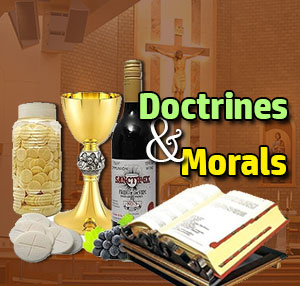THE TREE OF LIFE FOR THE HEALING OF A NATION

|
WHEN ONE PICKS UP his or her bible and opens Genesis 2, the description of the Garden of Eden, two trees are mentioned to be at the centre of the garden namely tree of life and tree of the knowledge of good and evil (Genn2:9). Many a reader has always in a haste taken this to be one tree. What Adam and Eve ate was the tree of the knowledge of good and evil. After the fall, God was concerned about their possibility of eating from the tree of life (Gen 3:22). As a consequence, they were driven out of the Garden of Eden. That is Genesis. But only few people are aware of the existence of this tree in Revelation. In fact, Revelation 22:2 speaks of this tree (possibly two of it), each at either side of the River of Life flowing from heaven and from the throne of God and of the Lamb (Rev 22:2). Here, the Tree of Life receives an elaborate description. It bears fruits every month and the leaves are medicinal for the healing of all nations. The depiction of the River of Life and the trees of a Garden is an imagery of an oriental paradise. At the course of my biblical research in Revelation, I have come to the conclusion that the New Heavenly Jerusalem is an eschatological version of the Garden of Eden. The existence of the Tree of Life is one of the points supporting my argument. The possible interpretation so far is that the bliss lost after the fall is restored here by God. However, we note some differences. There is no mention of the tree of the Knowledge of good and evil and instead of one, we have two Trees of Life here. Also, while the serpent, although cursed by God, remained in the Garden of Eden, Revelation 22 simply tells us that nothing cursed will be found in this eschatological garden. That the Garden of Eden is a place where God comes down to commune with the community of mankind, created male and female, finds an echo in describing the heavenly Jerusalem as a place where God dwells among men. Of all these, our attention is on the Tree of Life. The first mention of the Tree of Life in Revelation is in the letter to the Church at Ephesus in 2:7. “To everyone who conquers, I will give permission to eat from the Tree of Life that is in the paradise of God.” Apart from the Genesis background, tree of life has a local importance in Ephesus. The shrine of Artemis was originally a tree with an image of the goddess. Later, temples were successively built on this spot. D. G Hogarth in his excavation on the temple site claimed to have found the remains of this tree shrine. Also, numismatic evidences on this tree shrine abound today in the British Museum. Artemis is not only a goddess of fertility but also believed to grant life and protection to asylum seekers. Hence, John might be trying to tell his local audience that true life does not come from Artemis but from God, the source of the river of life. The detailed description of the Tree of Life is an allusion to Ezekiel 47:12 where all kinds of trees grow on both banks of the river flowing from the sanctuary of God down into Kidron Valley and finally into Arabah freshening the salty Dead Sea and making it possible for the survival of aquatic life therein. Because the source of the water is the sanctuary of God, it never runs dry and the trees will be ever green, bearing edible fruits on a monthly basis with the leaves medicinal. Whoever must have been to Jerusalem around the Temple area will appreciate the geographical exactitude of Ezekiel’s description. However, the life-giving water is more of a myth and leans back on the Garden of Eden in Genesis 2. Read in parallel with the vision of the dried bones in Ezekiel 37, we see emerging here the renewed life which God promised those returning from the exile. The exile in Ezekiel´s prophecy is a metaphor of death and the return a metaphor of resurrection. Hence both visions speak of a resurrection or new life that has its source in God the giver of life. In the Book of Proverbs there are mentions of the Tree of Life as wisdom (3:18), as the fruit of righteousness (11:30), as a fulfilled desire (13:12), and as a gentle tongue (15:4). In this wisdom tradition, the tree of life is more of human virtues as well as its reward. It is also found mentioned in many other apocalyptic writings such as 2 Esdra 8:52, 1 Enoch 25:5, 2 Enoch 8:3-4, Test Levi 18:11, 2 Bar 4, Test. Dan 5:12. It is believed that this tree will be transplanted to the temple of the Lord and will feed the righteous with food of immortality as a reward for their virtuous deeds. Hence the wisdom tradition and the apocalyptic current merge to see the tree of life both as a fruit of good deeds and as a reward from God himself. In all these backgrounds, how does one understand John’s use of the term in Revelation? First of all, we have to note that tree in Greek has two terms namely dendronand xulon and both in Hebrew are ´etz. Ordinary usage seems to differentiate the two by seeing xulon as wood and sacred trees while dendron is a fruit and forest tree. However, at some instances one notices that the difference is blurred and hence the two can be used interchangeably. John‘s preference for xulon apart from the consonance with the Septuagint, seems to have a cultic background namely the cross of Jesus Christ. Even though Revelation has a metaphor of death and a resurrection motif, it never used the word cross (stauros). The closely related word is crucified (estaurôthç). The imagery of the Lamb as slain (hôsesphagmenon) portrays the idea of the crucified and the water that flows the throne of God and of the Lamb waters the Tree of Life. Also, the ambiguity of number will be put into consideration here. The cross of Jesus is one but the Tree of Life stands on either bank of the River of Life. I am of the view that the Tree of Life is the fruit of Christ´s atoning death in an encounter with the heroic deeds of the virtuous. While the monthly fruits serve as food the leaves will be used for the healing of nations. This plays the same role with the blood of the Lamb as an instrument of ransom creating a new community out of people of all tribes, languages, peoples and nations (5:9). It is an antidote to a fragmented nation marked by a global mistrust and threatened by the danger of war and mutual annihilation. |
© 2024 - Catholic Archdiocese of Ibadan





